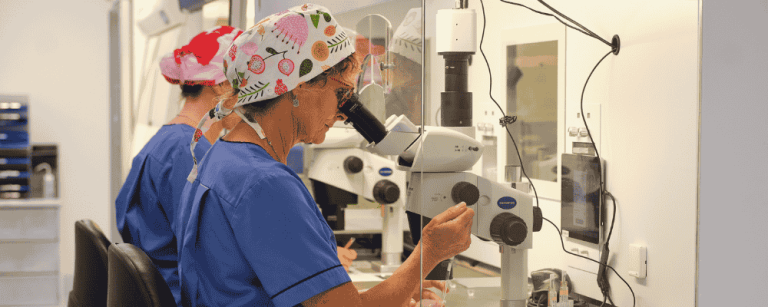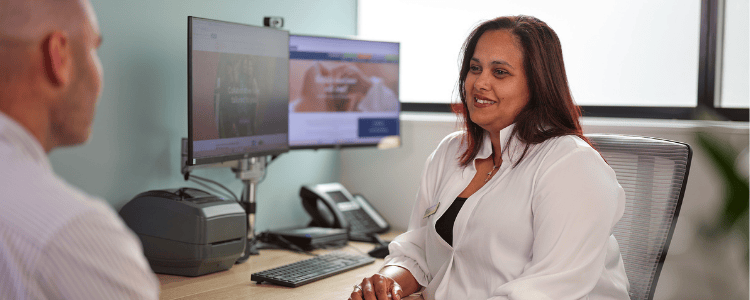The Repromed lab is where life begins. In Vitro Fertilisation (IVF) refers to fertilisation outside of the body. Eggs are collected and mixed with sperm in the laboratory.
We offer two different types of IVF treatment – standard IVF and ICSI.
Once embryos are created they are grown (cultured) in the laboratory where their development is observed. One embryo is replaced back to the uterus, hopefully generating a successful pregnancy.
✔ Suitable for those with fertility complications
✔ Options for rainbow families, solo parents or couples
✔ Personalised support from our team every step of the way

Please note that all semi-surgical procedures such as egg collections are carried out in affiliation with Repromed’s DAA accredited surgical unit ACSS (Auckland City Surgical Services) within the same building and using Repromed doctors.
Standard IVF is used for clients who have normal sperm parameters – normal numbers, normal motility and normal morphology. Standard IVF involves the insemination of prepared sperm into each dish containing eggs. The sperm are left to swim up to and fertilise the egg overnight.
Sperm related infertility accounts for around 50% of the infertility cases we see. But with specialised Intra-Cytoplasmic Sperm Injection technology (ICSI), we can often find sperm to use even in cases where there appears to be little hope.
ICSI involves the insertion of a single selected sperm directly into the cytoplasm of a mature egg. This procedure can overcome many barriers to fertilisation which can include failed fertilisation from previous use of standard IVF and in cases where there is extremely low sperm counts or motility.
If you’re wondering if sperm is playing a factor in your fertility, we recommend getting a sperm test – there are at home sperm testing kits or, your GP or Repromed can arrange a test.
Sperm meets egg in this video showing Intra-cytoplasmic Sperm Injection technology (ICSI). Watch this fascinating IVF process.
IVF treatment involves obtaining eggs from the ovaries. Ovaries are stimulated by administering injections of FSH (Follicle Stimulating Hormone), which encourages the development of several follicles (fluid filled sacs in the ovaries that usually contain eggs). This process normally takes about two weeks. Some clients with PCOS may also require Metformin. (Learn more about Metformin here.)
At time of egg collection there are usually five to ten follicles that have grown, however the number can vary greatly. Once enough follicles have matured the eggs are removed from the ovaries by passing a needle into the follicles and aspirating the fluid. The fluid is observed under a microscope where the eggs are removed and placed in a culture dish. This is a simple procedure that is performed in theatre by a doctor under light anaesthetic.
Following egg collection the semen sample will be collected and prepared. Sperm parameters will determine which preparation method is used, the aim is to harvest a high concentration of highly motile, morphologically normal sperm. The prepared sample is viewed under a microscope and sperm counted.
Standard IVF insemination involves a calculated volume of sperm being inseminated into each dish containing the collected eggs. For ICSI the procedure is quite different, it involves one of our scientists injecting a single sperm into each egg. After the sperm has come in contact with the egg, the dishes are left in the incubator overnight in the hope fertilisation will occur.
The morning after the egg collection, our scientists check the eggs for signs of fertilisation. If normal fertilisation has occurred the fertilised eggs are now called ‘embryos’ and are grown in the laboratory until they are ready to be placed back into the uterus.
The embryos are cultured at body temperature in our incubators for up to 5-6 days with the intention that an embryo will be transferred or frozen at the 60 cell plus stage. For some people however, they may require their embryos to be transferred at the earlier “8 cell cleavage stage” on Day 3, depending on the number of embryos they have.
Based on the information gained from daily observations, our scientists will decide when is best for your embryo to be transferred. The scientist will assess your embryos prior to transfer and choose the best quality embryo. This procedure is very simple, much like a smear test, and does not require an anaesthetic.
Following your transfer, any remaining viable embryos will be cultured and observed up to day six with freezing on day five and day six of suitable embryos. Our scientists will continue to inform you about what happens to your remaining embryos.
Fourteen days following your egg collection you will be asked to take your pregnancy test. This is done by a simple blood test.
If you’re trying to grow your whānau and haven’t had success, IVF may be one of the options available to you. It’s also a common path for solo parents or those using a sperm or egg donor.
We’ll help you explore all options before deciding together if IVF is right for you.
Providing an estimate for fertility treatment is difficult as there are so many considerations unique to your personal situation. As a guide, one cycle of IVF can cost between $16,000 and $20,000 which includes average medication costs and excludes genetic screening costs.
We also offer free public funding for up to two cycles of IVF, in the Northern Region. Find out more about public funding and check your eligibility, here.
For more information about treatment and medication costs please visit our costs page.
Our Repromed doctors offer a range of personalised treatment options called Add-ons which are innovative treatments based on scientific evidence that may help to enhance your chance of getting pregnant, based on your personal needs. Learn more here.

A typical IVF cycle takes around a month to complete and refers to the process of stimulating the ovaries, collecting eggs and sperm, fertilising the eggs, transferring an embryo back to the uterus, freezing surplus embryos and finishing with a pregnancy test. However in about 40% of cases, the cycle is shortened, with all the embryos being frozen, which are then available for thawing and transfer in one or more following menstrual cycles – we call this a freeze-only cycle.
The number of cycles you may go through to achieve a live birth will depend on your personal circumstances, including the type of infertility involved and health conditions.
A key contributing factor to the success rate of IVF, is a woman’s age. Women under the age of 35 have the highest chance of a birth while the most common age group who seek IVF treatment, those aged between 35 and 39, have a 23% rate of having a baby. However the cumulative chance of having a baby from each IVF cycle is increased with every additional embryo frozen.
For a full breakdown of what happens in an IVF cycle, click here.
IVF can be a good option for people who have been unsuccessful in first-line fertility treatments like Intrauterine Insemination (IUI) and Ovulation Induction (OI). Some situations where IVF may be considered include:
While there is no clear cut answer to this question, anyone who has viable eggs or embryos (either their own or from a donor) and a receptive uterus (their own or through a surrogate) are capable of having a live birth through IVF.
As mentioned, the success rates for IVF are dependent on your personal circumstances and age. A good resource is an online tool called Your IVF Success Estimator provided by the Australian Government. It may be able to assist with the decision making process for IVF, with the support of their Repromed fertility doctor.
The online calculator uses the main factors that are known to be associated with the success of IVF treatment. The estimate generated is based on the information you enter, and the chance of a live birth based on people who have had IVF treatment in Australasia with the same characteristics as you. The prediction is derived from the annual data collected by the National Perinatal Epidemiology and Statistics Unit (NPESU) of the University of New South Wales Sydney (UNSW) from all licensed New Zealand and Australian IVF clinics.
The Estimator can be helpful in providing a ballpark idea of the chance of success, however the estimate provided may not fully reflect the impact of your own individual clinical situation that would take into account such factors as your AMH (egg reserve) level. We therefore strongly recommend that it is used in conjunction with your fertility doctor’s advice and guidance. Click here to use the Estimator.
Everyone responds differently to IVF, but it would be fair to say the majority of people tolerate and manage the discomfort incredibly well. The fertility nurses genuinely empathise with the range of concerns that can naturally occur and are experts at listening and guiding you through this process. For some who find injections challenging, we recommend asking a partner or a friend to help you with them.
The egg collections usually take 10-15 minutes and most of our clients comment they can’t recall feeling pain during this procedure, due to the highly effective local anaesthetic and sedation that is used.
Historically, people having IVF treatment have had a higher chance of having twins or triplets because up to three embryos were transferred in each treatment cycle. These multiple pregnancies carried with them a significant risks of premature birth and health problems to the babies such as cerebral palsy, and for this reason, it is now standard practice in New Zealand to only transfer a single embryo in each IVF cycle.

Or, if you are ready to get started with treatment, you can book a first consultation with a fertility doctor where we can go in more depth with a treatment plan, provide you with next steps and if applicable, review eligibility for public funding.

DipNurs
Megan leads the nursing team through the continually changing face of IVF. She works in a multidisciplinary team, providing the essential organization between the doctors and laboratory and ensuring communication between all departments.
Megan started her IVF nursing career in the United Kingdom, working in two large London clinic’s before returning to New Zealand. She is also the Secretary of Fertility Nurses of Australasia.
I love working with people and see nursing as a vocation, not a job. I usually spend my downtime absorbed in a good book and planning my next travel adventure.